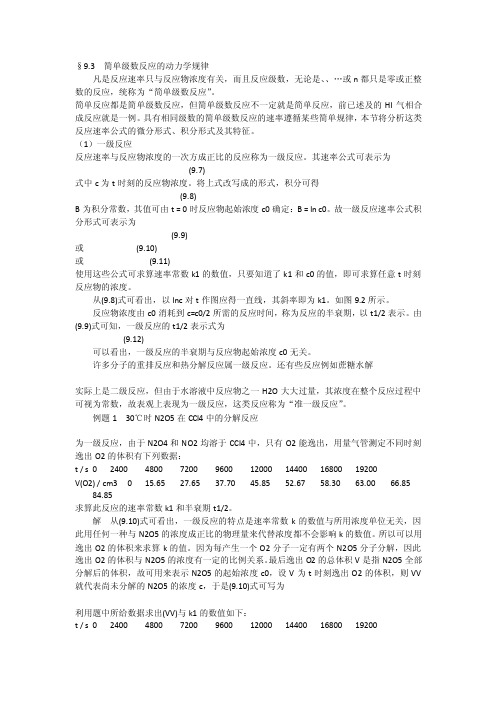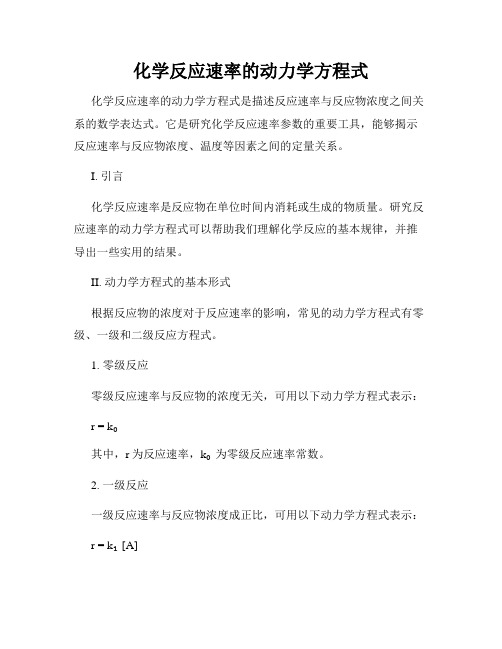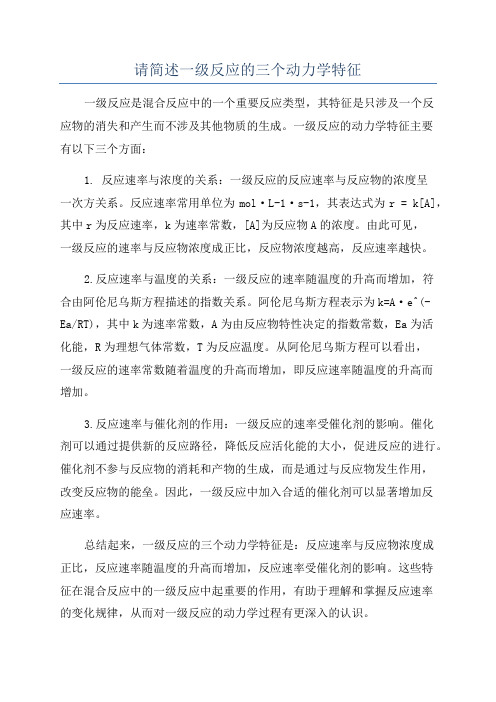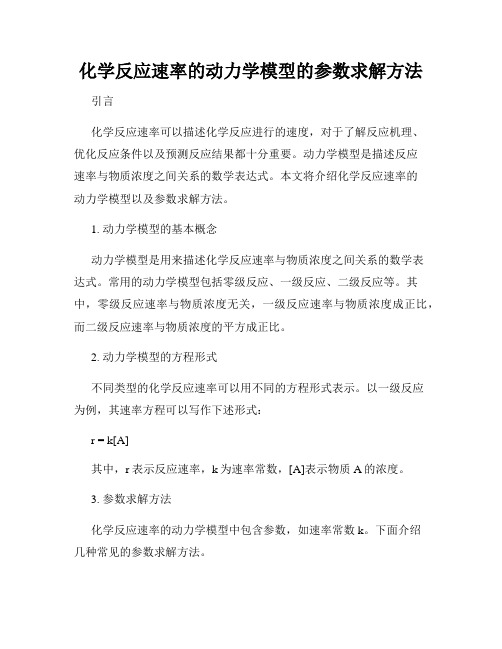一级反应动力学、二级反应动力学基本原理
第九章-化学动力学基本原理第1期

§9.3 简单级数反应的动力学规律凡是反应速率只与反应物浓度有关,而且反应级数,无论是、、…或n都只是零或正整数的反应,统称为“简单级数反应”。
简单反应都是简单级数反应,但简单级数反应不一定就是简单反应,前已述及的HI气相合成反应就是一例。
具有相同级数的简单级数反应的速率遵循某些简单规律,本节将分析这类反应速率公式的微分形式、积分形式及其特征。
(1)一级反应反应速率与反应物浓度的一次方成正比的反应称为一级反应。
其速率公式可表示为(9.7)式中c为t时刻的反应物浓度。
将上式改写成的形式,积分可得(9.8)B为积分常数,其值可由t = 0时反应物起始浓度c0确定:B = ln c0。
故一级反应速率公式积分形式可表示为(9.9)或(9.10)或(9.11)使用这些公式可求算速率常数k1的数值,只要知道了k1和c0的值,即可求算任意t时刻反应物的浓度。
从(9.8)式可看出,以lnc对t作图应得一直线,其斜率即为k1。
如图9.2所示。
反应物浓度由c0消耗到c=c0/2所需的反应时间,称为反应的半衰期,以t1/2表示。
由(9.9)式可知,一级反应的t1/2表示式为(9.12)可以看出,一级反应的半衰期与反应物起始浓度c0无关。
许多分子的重排反应和热分解反应属一级反应。
还有些反应例如蔗糖水解实际上是二级反应,但由于水溶液中反应物之一H2O大大过量,其浓度在整个反应过程中可视为常数,故表观上表现为一级反应,这类反应称为“准一级反应”。
例题1 30℃时N2O5在CCl4中的分解反应为一级反应,由于N2O4和NO2均溶于CCl4中,只有O2能逸出,用量气管测定不同时刻逸出O2的体积有下列数据:t / s 0 2400 4800 7200 9600 12000 14400 16800 19200V(O2) / cm3 0 15.65 27.65 37.70 45.85 52.67 58.30 63.00 66.8584.85求算此反应的速率常数k1和半衰期t1/2。
化学反应速率的动力学方程式

化学反应速率的动力学方程式化学反应速率的动力学方程式是描述反应速率与反应物浓度之间关系的数学表达式。
它是研究化学反应速率参数的重要工具,能够揭示反应速率与反应物浓度、温度等因素之间的定量关系。
I. 引言化学反应速率是反应物在单位时间内消耗或生成的物质量。
研究反应速率的动力学方程式可以帮助我们理解化学反应的基本规律,并推导出一些实用的结果。
II. 动力学方程式的基本形式根据反应物的浓度对于反应速率的影响,常见的动力学方程式有零级、一级和二级反应方程式。
1. 零级反应零级反应速率与反应物的浓度无关,可用以下动力学方程式表示:r = k₀其中,r为反应速率,k₀为零级反应速率常数。
2. 一级反应一级反应速率与反应物浓度成正比,可用以下动力学方程式表示:r = k₁[A]其中,r为反应速率,k₁为一级反应速率常数,[A]为反应物A的浓度。
3. 二级反应二级反应速率与反应物浓度的乘积成正比,可用以下动力学方程式表示:r = k₂[A]²其中,r为反应速率,k₂为二级反应速率常数,[A]为反应物A的浓度。
III. 动力学方程式的推导动力学方程式的推导通常基于反应速率与反应物浓度之间的实验数据。
通过确定不同反应物浓度下的反应速率,可以获得动力学方程式中的速率常数。
1. 零级反应方程式的推导对于一个零级反应,反应速率不随反应物浓度的变化而变化。
通过实验测得不同时间点下反应物的浓度,可以得到零级反应速率常数。
2. 一级反应方程式的推导一级反应速率与反应物浓度成正比。
可以通过实验测得在不同反应物浓度下的反应速率,并进行数学处理,得到一级反应速率常数。
3. 二级反应方程式的推导二级反应速率与反应物浓度的平方成正比。
通过实验测得不同反应物浓度下的反应速率,并进行数学处理,可以得到二级反应速率常数。
IV. 动力学方程式的应用动力学方程式在化学工程、药学、环境科学等领域有广泛应用。
它可以帮助我们理解反应速率的变化规律,并预测反应物浓度随时间的变化趋势。
一级反应动力学、二级反应动力学基本原理

Rate Laws 速率定律
Rate law = a mathematical function describing the turnover rate of the compound of interest as a function of the concentrations of the various species participating in the reaction
Wikipedia
Pseudo first order reactions 伪一级反应
• pseudo-first order: concentration of one reactant remains essentially constant over time (often because it is in large excess compared to the other reactant)
- dA = k[A]1 = k[A] dt
Take integral of equation above, and get equation below: 将以上等式积分,得到下面的等式:
[A]t [A]0ekt
Plot of first order reaction 一级动力反应的图片
半衰期的长度固定
R a t e=c o n t c ie m n e t r c a h t a io n n g e c h a n g e
反应速率=△浓度/△时间
R ate=___ in __ [p _ r_ od _u _ c _ ts_ ]___=____ in __ [r_ e_ ac _ ta _n _ t_ s]__ changeintim e changeintim e
请简述一级反应的三个动力学特征

请简述一级反应的三个动力学特征一级反应是混合反应中的一个重要反应类型,其特征是只涉及一个反应物的消失和产生而不涉及其他物质的生成。
一级反应的动力学特征主要有以下三个方面:1. 反应速率与浓度的关系:一级反应的反应速率与反应物的浓度呈一次方关系。
反应速率常用单位为mol·L-1·s-1,其表达式为r = k[A],其中r为反应速率,k为速率常数,[A]为反应物A的浓度。
由此可见,一级反应的速率与反应物浓度成正比,反应物浓度越高,反应速率越快。
2.反应速率与温度的关系:一级反应的速率随温度的升高而增加,符合由阿伦尼乌斯方程描述的指数关系。
阿伦尼乌斯方程表示为k=A·e^(-Ea/RT),其中k为速率常数,A为由反应物特性决定的指数常数,Ea为活化能,R为理想气体常数,T为反应温度。
从阿伦尼乌斯方程可以看出,一级反应的速率常数随着温度的升高而增加,即反应速率随温度的升高而增加。
3.反应速率与催化剂的作用:一级反应的速率受催化剂的影响。
催化剂可以通过提供新的反应路径,降低反应活化能的大小,促进反应的进行。
催化剂不参与反应物的消耗和产物的生成,而是通过与反应物发生作用,改变反应物的能垒。
因此,一级反应中加入合适的催化剂可以显著增加反应速率。
总结起来,一级反应的三个动力学特征是:反应速率与反应物浓度成正比,反应速率随温度的升高而增加,反应速率受催化剂的影响。
这些特征在混合反应中的一级反应中起重要的作用,有助于理解和掌握反应速率的变化规律,从而对一级反应的动力学过程有更深入的认识。
化学反应速率的动力学模型的参数求解方法

化学反应速率的动力学模型的参数求解方法引言化学反应速率可以描述化学反应进行的速度,对于了解反应机理、优化反应条件以及预测反应结果都十分重要。
动力学模型是描述反应速率与物质浓度之间关系的数学表达式。
本文将介绍化学反应速率的动力学模型以及参数求解方法。
1. 动力学模型的基本概念动力学模型是用来描述化学反应速率与物质浓度之间关系的数学表达式。
常用的动力学模型包括零级反应、一级反应、二级反应等。
其中,零级反应速率与物质浓度无关,一级反应速率与物质浓度成正比,而二级反应速率与物质浓度的平方成正比。
2. 动力学模型的方程形式不同类型的化学反应速率可以用不同的方程形式表示。
以一级反应为例,其速率方程可以写作下述形式:r = k[A]其中,r表示反应速率,k为速率常数,[A]表示物质A的浓度。
3. 参数求解方法化学反应速率的动力学模型中包含参数,如速率常数k。
下面介绍几种常见的参数求解方法。
3.1. 初始斜率法初始斜率法是一种常用的参数求解方法,适用于一级反应或伪一级反应。
该方法基于速率和浓度的关系,通过对实验数据进行初始时刻的线性拟合,求解得到速率常数k。
3.2. 最小二乘法最小二乘法是一种常见的参数拟合方法,可以用于各类反应动力学模型。
该方法通过最小化测量值与拟合值之间的误差平方和,得到最优拟合参数。
在动力学模型中,最小二乘法可用于求解速率常数k以及其他反应动力学参数。
3.3. 线性回归法线性回归法是一种参数拟合方法,适用于一些特定的动力学模型。
该方法将动力学模型转化为线性形式,通过对实验数据进行线性回归,求解得到参数。
3.4. 数值模拟方法数值模拟方法是一种基于计算机模拟的参数求解方法,对于复杂的反应动力学模型尤为有效。
该方法通过数值求解微分方程组,得到参数的近似解。
数值模拟方法的求解过程较为复杂,但能够提供较为准确的结果。
总结化学反应速率的动力学模型能够描述反应速率与各种影响因素之间的关系,对于研究化学反应机理、优化反应条件以及预测反应结果具有重要意义。
一级反应和二级反应

一级反应和二级反应一级反应和二级反应是两个概念,它们通常用于描述化学反应的速率与反应物浓度之间的关系。
下面将详细介绍一级反应和二级反应的定义、速率方程、图像、实例和应用。
一、一级反应1.定义:一级反应是指反应速率与反应物浓度之间存在直接线性关系的化学反应。
即,反应速率随着反应物浓度的增加而线性增加。
2.速率方程:一级反应的速率方程可以表示为:r = k[A],其中r 为反应速率,k为速率常数,[A]为反应物A的浓度。
3.图像:一级反应的速率与时间的关系呈指数衰减,即当反应开始时,反应速率最大,随着时间的推移逐渐降低。
4.实例:一个常见的一级反应实例是放射性衰变。
例如,放射性同位素的衰变速率与其浓度成正比。
5.应用:一级反应常用于测定化学反应速率常数和半衰期。
例如,在药物代谢研究中,一级反应用于确定药物在体内的代谢速率。
二、二级反应1.定义:二级反应是指反应速率与反应物浓度的平方成正比的化学反应。
即,反应速率与反应物浓度之间存在二次关系。
2.速率方程:二级反应的速率方程可以表示为:r = k[A]^2,其中r为反应速率,k为速率常数,[A]为反应物A的浓度。
3.图像:二级反应的速率与时间的关系通常呈现出一个抛物线形状。
在反应早期,速率很快增加,随着反应物浓度的减少,速率逐渐减小。
4.实例:一个常见的二级反应实例是二次分解反应。
例如,硝酸银与氯化铁反应生成银(I)氯化物和亚铁(III)离子。
5.应用:二级反应在环境科学中很常见,用于研究废水处理、大气污染和土壤污染等领域。
此外,二级反应也常用于研究化学反应速率方程。
总结:一级反应和二级反应是两种常见的化学反应类型。
一级反应中,反应速率与反应物浓度成线性关系;而二级反应中,反应速率与反应物浓度的平方成正比。
了解一级反应和二级反应的定义、速率方程、图像、实例和应用可以帮助我们更好地理解化学反应的动力学过程,并在相关领域的研究中应用这些知识。
一级反应动力学、二级反应动力学基本原理
Rate Laws 速率定律
Rate law = a mathematical function describing the turnover rate of the compound of interest as a function of the concentrations of the various species participating in the reaction
2N2O5(g) 4NO2(g) + O2(g)
Rate of reaction
=
-
1 2
[N2O5] t
=
1 [NO2] 4 t
=
[O2] t
பைடு நூலகம்
• Rate may be expressed in three main ways: •反应速率主要有以下三个表达方式: 1. Average reaction rate: a measure of the change in concentration with time
Further Reading (Chapter 3 in Hobbs)
• Rate of reaction is typically measured as the change in concentration (moles/L) with time 反应速率通常通过浓度(mol/L)随时间的变化来测量 This change may be a decrease or an increase •改变可能是增加的也可能是减小的 • Likewise the concentration change may be of reactants or products 同样,改变浓度的物质可能是反应物也可能是生成物
化学反应的动力学方程
化学反应的动力学方程化学反应的动力学方程是用来描述反应速率与反应物浓度之间关系的数学表达式。
它对理解和预测反应速率至关重要,对于实际化学反应的控制和优化具有重要意义。
本文将介绍化学反应动力学方程的基本概念、常见类型以及求解方法。
一、动力学方程的基本概念化学反应的速率是指单位时间内发生的反应物消耗或生成物产生的量。
在理想条件下,反应速率与反应物浓度成正比。
因此,可以用一个动力学方程来描述反应速率随反应物浓度变化的关系。
二、简单反应动力学方程1. 一级反应动力学方程一级反应是指反应速率与反应物浓度的一次方成正比。
一级反应动力学方程可以写成以下形式:Rate = k[A]其中,Rate表示反应速率,k表示反应速率常数,[A]表示反应物A 的浓度。
2. 二级反应动力学方程二级反应是指反应速率与反应物浓度的二次方成正比。
二级反应动力学方程可以写成以下形式:Rate = k[A]^2其中,Rate表示反应速率,k表示反应速率常数,[A]表示反应物A 的浓度。
3. 伪一级反应动力学方程伪一级反应是指反应物A的浓度远远大于反应物B的浓度,反应速率主要由B的浓度决定。
伪一级反应动力学方程可以写成以下形式:Rate = k[B]其中,Rate表示反应速率,k表示反应速率常数,[B]表示反应物B 的浓度。
三、复杂反应动力学方程对于复杂的化学反应,动力学方程可能涉及多个反应物和生成物的浓度。
根据反应机理和实验数据,可以利用实验拟合等方法确定反应动力学方程的形式。
四、动力学方程的求解方法1. 已知反应速率常数,求解反应物浓度随时间的变化通过解反应动力学方程,可以求解反应物浓度随时间的变化。
具体的求解方法包括解微分方程、使用数值方法进行模拟等。
2. 已知反应物浓度随时间的变化,求解反应速率常数通过测定反应物浓度随时间的变化,可以利用反应动力学方程求解反应速率常数。
常用的方法包括初始速率法、半衰期法等。
五、总结化学反应的动力学方程是描述反应速率与反应物浓度之间关系的数学表达式。
一级反应动力学二级反应动力学基本原理
一级反应动力学二级反应动力学基本原理r=k[A]其中,r表示反应速率,k表示速率常数,[A]表示反应物A的浓度。
根据该公式,可以得出以下结论:1.反应速率与反应物浓度成正比。
反应速率随着反应物浓度增加而增加,随着反应物浓度减少而减少。
这是因为在反应物浓度较高时,反应物分子之间的碰撞频率较高,从而增加了反应发生的机会。
2.反应速率与速率常数成正比。
速率常数是描述反应的快慢程度的参数,反应速率越大,反应快慢程度就越高。
速率常数与反应物的特性以及反应条件有关,可以通过实验测定得到。
3.反应速率与反应物的指数关系。
在一级反应动力学中,反应速率与反应物浓度的指数关系为一次方程。
这表示反应速率对于反应物浓度的敏感度比较强,即反应速率的变化明显受到反应物浓度的影响。
二级反应动力学是描述反应物浓度随时间变化的动力学模型。
二级反应动力学的基本原理可以通过以下公式表示:r=k[A][B]其中,r表示反应速率,k表示速率常数,[A]和[B]表示反应物A和B的浓度。
根据该公式,可以得出以下结论:1.反应速率与反应物浓度成正比。
与一级反应动力学类似,反应速率随着反应物浓度的增加而增加,随着反应物浓度的减少而减少。
但是,与一级反应不同的是,二级反应动力学中反应速率与反应物的乘积成正比。
2.反应速率与速率常数成正比。
速率常数仍然是描述反应的快慢程度的参数,反应速率越大,反应快慢程度就越高。
速率常数与反应物的特性以及反应条件有关,可以通过实验测定得到。
3.反应速率与反应物的指数关系为二次方程。
这表示反应速率对于反应物浓度的敏感度比较强,反应速率的变化明显受到反应物浓度的影响。
以上是一级反应动力学和二级反应动力学的基本原理。
这两种动力学模型可以用于描述不同类型的反应。
在实际应用中,我们可以通过改变反应物浓度或者控制反应条件,来控制反应的速率和进程,从而实现对化学反应的控制和优化。
一级反应的动力学特征
一级反应的动力学特征1.引言1.1 概述一级反应是化学反应中最简单且最常见的一种反应类型之一。
它是指反应物中的一种物质以一定速率转化为生成物的过程。
在一级反应中,反应物的浓度对反应速率的影响十分明显,因此可以通过控制反应物的浓度来调节反应速率。
一级反应的动力学特征主要指的是反应速率随时间的变化规律,以及反应速率方程和速率常数的表达式。
通过研究一级反应的动力学特征,我们可以深入了解反应过程中的分子运动规律,揭示反应速率与反应物浓度之间的定量关系。
在一级反应中,反应速率随时间的变化呈指数衰减的趋势。
初始时刻,反应速率最大,随着反应进行,反应物浓度逐渐降低,反应速率也随之减小。
这是因为一级反应反应物的消耗速度与反应物浓度成正比。
一级反应的速率方程可以用数学公式表示为:v = k[A],其中v表示反应速率,k表示反应速率常数,[A]表示反应物A的浓度。
该公式表明,反应速率与反应物浓度成正比。
在一级反应中,速率常数k是一个与温度相关的常数,它受到反应物的性质和反应条件的影响。
研究一级反应的动力学特征对于我们理解和控制化学反应过程具有重要意义。
首先,通过测定一级反应的速率常数可以推断反应机理和反应物之间的相互作用方式。
其次,我们可以通过调节反应物浓度来控制反应速率,从而实现对化学反应过程的控制和优化。
最后,一级反应的动力学特征在工业领域有着广泛的应用,例如药物研发、催化剂设计等。
综上所述,一级反应的动力学特征是研究化学反应过程中的重要内容。
通过深入了解一级反应的速率方程和速率常数,我们能够揭示反应物浓度对反应速率的影响规律,为实现化学反应过程的控制和优化提供理论指导。
1.2文章结构1.2 文章结构本文将按照以下结构进行论述:第一部分是引言,分为三个小节。
首先概述一级反应的动力学特征,并简要介绍该反应的基本概念。
接着,说明文章的结构,即本文将从一级反应的定义和基本概念开始,逐步深入研究一级反应的速率方程和速率常数。
- 1、下载文档前请自行甄别文档内容的完整性,平台不提供额外的编辑、内容补充、找答案等附加服务。
- 2、"仅部分预览"的文档,不可在线预览部分如存在完整性等问题,可反馈申请退款(可完整预览的文档不适用该条件!)。
- 3、如文档侵犯您的权益,请联系客服反馈,我们会尽快为您处理(人工客服工作时间:9:00-18:30)。
Rate Laws
A + B + C ===> products
“m, n, o” indicate the order of the reaction with respect to each species; determine experimentally
dA m n o = -k × [ A ] × [ B ] × [ C ] dt
May or may NOT have a theoretical basis可能有或没有 理论基础 “Many reactions occur at a decreasing rate with increasing time because the reaction rate diminishes as the concentrations of the reactants diminish” “很多反应随着时间的增加反应速率逐渐减小?,因为反应物浓 度减小会降低反应速率” Hobbementary 基本反应速率定律
• Simple to write 书写简单
• Unimolecular H2CO3 H+ + HCO3d[H2CO3]/dt = k[H2CO3]
• Bimolecular CO2 + H2O H2CO3
d[CO2]/dt = k[CO2][H2O]
dA 1 = k[ A] = k[ A] dt
Take integral of equation above, and get equation below: 将以上等式积分,得到下面的等式:
[ A]t [ A]0 e
kt
Plot of first order reaction 一级动力反应的图片
Rate of = - 1 [N2O5] = 1 [NO2] = reaction 2 4 t t
[O2] t
• Rate may be expressed in three main ways: •反应速率主要有以下三个表达方式: 1. Average reaction rate: a measure of the change in concentration with time 1、平均反应速率:浓度随时间变化的度量 2. Instantaneous rate: rate of change of concentration at any particular instant during the Reaction 2、瞬时速率:反应过程中某一特定瞬间的浓度变化速率 3. Initial rate: instantaneous rate at t = 0 - that is, when the reactants are first mixed 3、初始速率:t=0时即反应物最初混合时的瞬时速率,
半衰期的长度固定
t½ = 0.693 / k
Example of 1st order reaction 1级动力反应范例
H2O2 (l) H2O(l) + 1/2O2(g)
If a reaction has a single reactant and the value of the exponent is one, then it is said to be a first-order reaction. 如果反应物只有一种,而且指数为1,那么称这种反应为一级动 力反应 Write rate law for above equation:
Single Step (Elementary) Reaction Process 单步(基本)反应过程
• • • • • Unimolecular 单分子反应 CaCO3 Ca2+ + CO32Bimolecular 双分子反应 CO2 + H2O H2CO3 Termolecular 三分子反应 2 FeS2 + 3 O2 + 2 H2O 2 Fe3+ + 4H2SO4 • No four or more molecule processes have been identified because chances of 4 molecules colliding is very, very small (making reaction rate super small) • 没有4或者4以上的分子反应被检测到,因为4分子同时碰撞的 机会非常非常小(使得反应速率非常小)
overall reaction order = m+n+o
“m, n, o”分别是关于每种物质的反应级数,实验确定的总反 应级数=m+n+o Reaction orders can be: first, second, third
反应级数可以是一级、二级、三级
First order reactions 一级动力反应
2NO2 (g) 2NO(g) + O2(g)
CO2 + H2O H2CO3
A second-order reaction depends on the concentrations of one second-order reactant, or two first-order reactants. 二级动力反应取决是否有一个二级反应物或者两个一级反应物? Write rate law for above equations:
“m”指关于物质A的反应级数,由实验确定。
“k” = rate coefficient (or specific reaction rate coeff.); determined for a specific reaction at a specific temp
“K”=速率常数(或特定的速率系数),由特定温度下的具体反应 确定
concentration change Rate = time change
反应速率=△浓度/△时间
in [products] in [reactants] Rate = ______________ = ______________ change in time change in time
• Rate has units of moles per liter per unit time - M s-1, M h-1 速率的单位是摩尔每升每单位时间,如M s-1、M h-1 Consider the hypothetical reaction 对于这个假设的反应 aA + bB cC + dD • We can write
Plot of second order reaction 2级动力反应图
[A]
time
Half lives are not constant with time for second order reactions 二级反应动力学反应物质的半衰期随时间推移变化
t½ = 1 / k [Ao]
Example of 2nd order reaction 二级动力反应范例
A+B®C+D dA = -k[ A ][ B ] dt dA = -k '[ A] where k ' = k[ B ] dt ln[ A ] = ln[ A]0 - k ' t
B浓度不变
Reaction Mechanism反应机理
• Often we write a chemical reaction 我们经 常写化学反应式 • How we write it is often not how it happens • 但是我们所写的通常不是它如何发生的 • Many kinds of reaction mechanisms • 有很多反应的机理
Rate Laws 速率定律
Rate law = a mathematical function describing the turnover rate of the compound of interest as a function of the concentrations of the various species participating in the reaction 速率定律:用来描述相关的化合物的转化速率的数学函数,即各 种参与反应的物质的浓度的函数
Important Note重要提示
Reaction order is not necessarily related to the stoichiometry of the reaction, unless the reaction is elementary. 反应级数不一定和反应的化学计量数有关,除非反应是基本反应 In single step process, reaction order = coefficient of reactant in chemical equation 在单步反应过程中,反应级数=化学式中反应物的系数 Complex reactions may or may not have reaction orders equal to their stoichiometric coefficients 复杂反应的反应级数可能和化学计量系数相等 Not all first order reactions, are single step, monomolecular reactions 不是所有的一级反应都是单步反应、单分子反应
Kinetics动力学
• Thermodynamics determines whether and in which direction a reaction will happen, and what the concentrations of constituents are involved in the reaction • 热力学决定了反应是否发生、反应的方向以及参与到反应 之中的物质浓度问题。 • Kinetics say how fast a reaction happens, sequence of steps in the reaction, and some of the factors that control the rates of reactions • 动力学则说明反应发生的速率有多快、反应步骤的顺序以 及控制反应速率的一些因素
